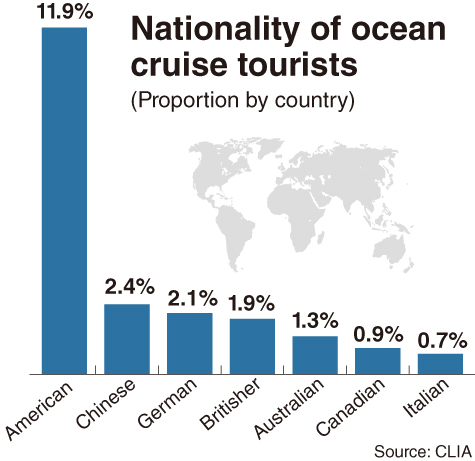SEJONG -- South Korea has five international cruise terminals -- two in Jeju, one in Busan, one in Sokcho and one in Incheon.
With the Ministry of Oceans and Fisheries focusing on the development of cruise tourism, its plan to open a new Jeju Port, aimed at handling a greater number of inbound cruise tourists, has been approved by the Cabinet.
The endorsed budget for the third ocean cruise terminal on Jeju Island -- with the capacity to manage 4.7 million tourists per year -- is set at 2.8 trillion won ($2.3 billion).
 |
Passengers of a cruise ship enjoy movies on deck. (Onlinetour.co.kr) |
The new cruise-oriented harbor will be constructed on the northern part of the island, including areas in Yongdam-dong, Samdo-dong and Geonip-dong, by 2040.
“Four big-scale cruise ships and nine passenger ships can be anchored simultaneously at the new port,” said a ministry official. “In addition, a complex with 820,000 square meters for leisure and tour activities will be built around the passenger terminal.”
Central and local government officials expect the new Jeju Port to take the initiative in attracting inbound tourists alongside the Songdo International Cruise Terminal in Incheon, which opened earlier this year.
A government official said the new port could possibly be the largest in Northeast Asia.
Meanwhile, the Oceans Ministry has increased the budget for cruise terminals at major ports.
In September 2018, the nation held an opening ceremony for a cruise-only terminal at Busan North Port in the city’s Yeongdo district. The government allocated a budget of 5.3 billion won for improvements to Busan North Port and Busan Port.
The redevelopment project for Busan North Port looks to the cases of Hong Kong and Singapore, where various cultural, global-oriented facilities will be fostered by 2030.
As part of its move to create a Northeast Asian cruise hub, the Oceans Ministry last year invited 10 global cruise ship operators, including Royal Caribbean, Princess, Costa and Carnival, in coordination with the local governments of Incheon, Busan, Jeju, South Jeolla Province and Gangwon Province.
Though Korea’s ocean tourism sector is underdeveloped compared to that of major countries, interest is growing rapidly among Koreans in line with the fast expansion of the cruise segment in the global travel market.
According to the 2019 Cruise Trends & Industry Outlook report, released by the Cruise Lines International Association, the ocean cruise market has grown 68 percent in passenger numbers over the past decade.
 |
(Graphic by Han Chang-duck/The Korea Herald) |
The number of yearly cruise passengers is estimated to have reached 30 million in 2019 globally, compared to 22.3 million in 2014 and 17.8 million in 2009.
US citizens made up a major proportion of cruise passengers at 11.9 percent, followed by Chinese at 2.4 percent and Germans at 2.1 percent, according to data from Washington, DC-based CLIA.
Tourists from the UK ranked fourth with 1.9 percent, followed by Australians with 1.3 percent, Canadians with 0.9 percent and Italians with 0.7 percent. Among those in the top 10 were the Spanish (0.5 percent), French (0.5 percent) and Brazilians (0.4 percent).
Meanwhile, Korea is bidding for foreign harbor renovation projects in popular destinations for international cruise ships.
The Oceans Ministry has held a series of talks with its Nicaraguan counterpart to improve harbor conditions to attract global cruise vessels.
Harbors in Central America -- both for the Caribbean Sea and Pacific Ocean sides -- are among the top cruise tourist destinations.
But huge ships have to anchor off harbors at some locations due to less-developed passenger terminals, meaning cruise tourists have to use shuttle boats to reach the destinations rather than walk ashore.
The Oceans Ministry held detailed talks last November in the Nicaraguan capital of Managua. The Nicaraguan government has reportedly mapped out plans to modernize harbors and upgrade passenger terminals in coordination with Korea.
Korea is also hoping to expand talks to Honduras and Costa Rica for joint development of the west Caribbean coastline.
By Kim Yon-se (
kys@heraldcorp.com)









